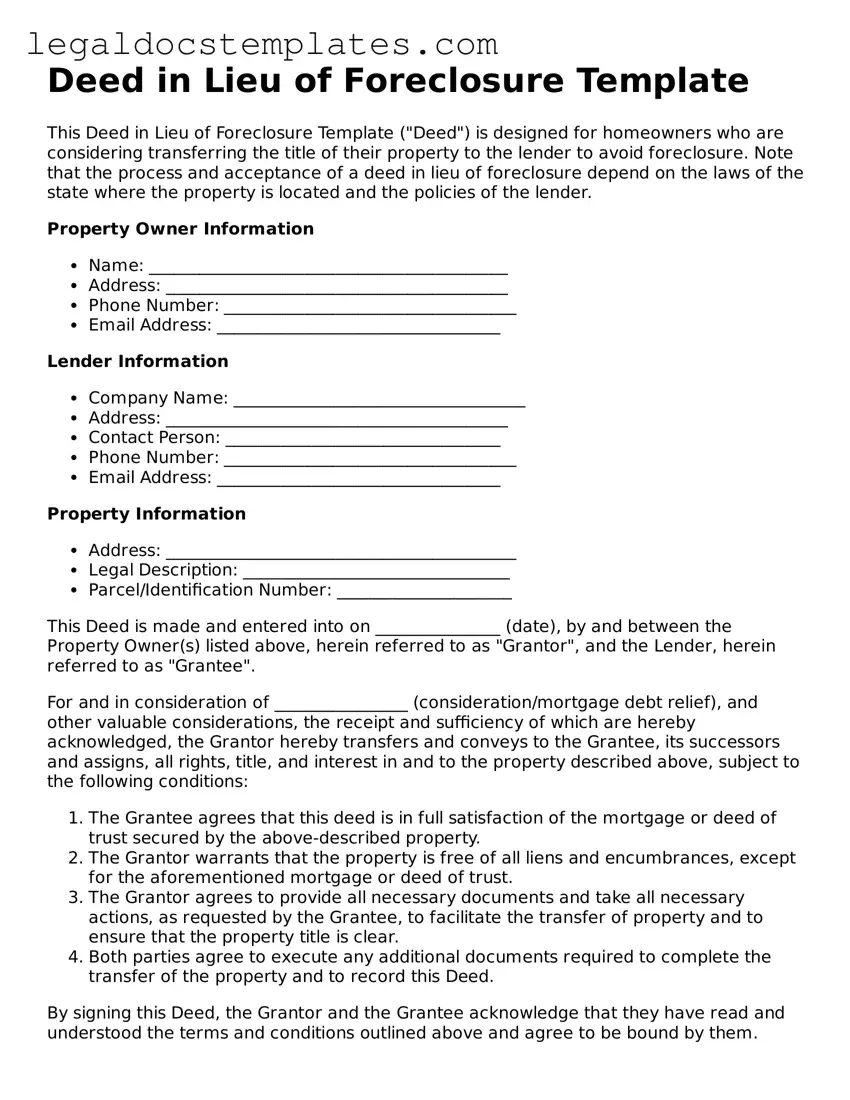Deed in Lieu of Foreclosure Template
This Deed in Lieu of Foreclosure Template ("Deed") is designed for homeowners who are considering transferring the title of their property to the lender to avoid foreclosure. Note that the process and acceptance of a deed in lieu of foreclosure depend on the laws of the state where the property is located and the policies of the lender.
Property Owner Information
- Name: ___________________________________________
- Address: _________________________________________
- Phone Number: ___________________________________
- Email Address: __________________________________
Lender Information
- Company Name: ___________________________________
- Address: _________________________________________
- Contact Person: _________________________________
- Phone Number: ___________________________________
- Email Address: __________________________________
Property Information
- Address: __________________________________________
- Legal Description: ________________________________
- Parcel/Identification Number: _____________________
This Deed is made and entered into on _______________ (date), by and between the Property Owner(s) listed above, herein referred to as "Grantor", and the Lender, herein referred to as "Grantee".
For and in consideration of ________________ (consideration/mortgage debt relief), and other valuable considerations, the receipt and sufficiency of which are hereby acknowledged, the Grantor hereby transfers and conveys to the Grantee, its successors and assigns, all rights, title, and interest in and to the property described above, subject to the following conditions:
- The Grantee agrees that this deed is in full satisfaction of the mortgage or deed of trust secured by the above-described property.
- The Grantor warrants that the property is free of all liens and encumbrances, except for the aforementioned mortgage or deed of trust.
- The Grantor agrees to provide all necessary documents and take all necessary actions, as requested by the Grantee, to facilitate the transfer of property and to ensure that the property title is clear.
- Both parties agree to execute any additional documents required to complete the transfer of the property and to record this Deed.
By signing this Deed, the Grantor and the Grantee acknowledge that they have read and understood the terms and conditions outlined above and agree to be bound by them.
In witness whereof, the parties have executed this Deed as of the day and year first above written.
Grantor's Signature: _____________________________
Grantee's Signature: _____________________________
Notary Public
State of ______________________
County of _____________________
On _______________ (date), before me, ___________________________________ (notary's name), personally appeared _________________________ (names of signatories), known to me (or satisfactorily proven) to be the individuals whose names are subscribed to the within instrument and acknowledged that they executed the same for the purposes therein contained.
In witness whereof, I hereunto set my hand and official seal.
______________________________________
Notary Public (Signature)
My Commission Expires: __________________
